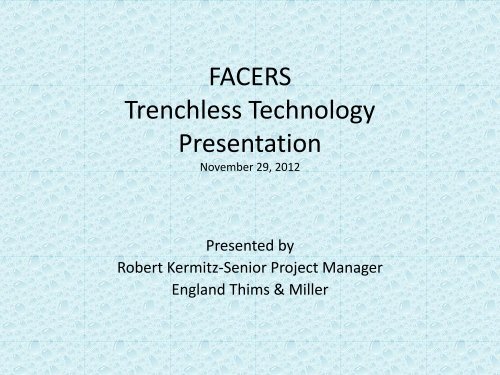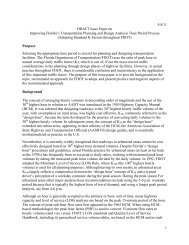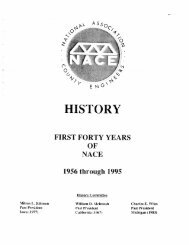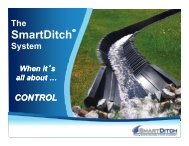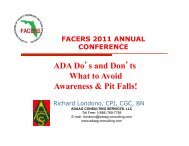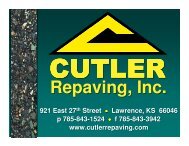FACERS Trenchless Technology Presentation
FACERS Trenchless Technology Presentation
FACERS Trenchless Technology Presentation
Create successful ePaper yourself
Turn your PDF publications into a flip-book with our unique Google optimized e-Paper software.
<strong>FACERS</strong><br />
<strong>Trenchless</strong> <strong>Technology</strong><br />
<strong>Presentation</strong><br />
November 29, 2012<br />
Presented by<br />
Robert Kermitz-Senior Project Manager<br />
England Thims & Miller
<strong>Trenchless</strong> <strong>Technology</strong><br />
• Why?<br />
– Add tools to your toolkit!<br />
• Why?<br />
– Gives you alternatives when managing your ROW<br />
• Why?<br />
– Less impact to your customers/constituents<br />
• Why?<br />
– Might save you time and money!!!!!
Infrastructure<br />
What’s really down there???
Infrastructure Issues<br />
• Aging water, sewer, storm systems all over the US are<br />
resulting in costly failures<br />
• Utility Owners and ROW Owners are sometime in<br />
conflict on projects due to congested ROW’s<br />
• Utility’s have deteriorating infrastructure<br />
• Need for larger capacity infrastructure (roadway or<br />
utility). Growth will continue!<br />
• <strong>Trenchless</strong> <strong>Technology</strong> tools can sometimes mitigate<br />
these conflicts at lower cost and with less impact<br />
• <strong>Trenchless</strong> rehabilitation of infrastructure is another<br />
tool in your toolkit
Infrastructure Failures
Infrastructure Failures
Infrastructure<br />
Failures<br />
• Sinkhole opened underneath a Ford Explorer in Brooklyn, N.Y., on March 27,<br />
2006.<br />
• A woman driving her SUV along a Brooklyn street plunged into a cavernous<br />
sinkhole caused by water leaking from an underground main.<br />
• This occurred at 3:36 a.m. An 18-inch gas pipe prevented the Ford Explorer<br />
from toppling farther into the 20-foot-deep hole at 73rd Street and Fourth<br />
Avenue
Infrastructure<br />
Failures<br />
Arizona-2008<br />
The initial cause of the sinkholes remains<br />
unclear, but the 42" sewer main which was<br />
crushed and plugged was aging and<br />
scheduled for renovation in the near future.<br />
The sewer line was a large interceptor that<br />
carried 32 million gallons of sewage
Infrastructure Failures
Infrastructure Failures<br />
This is not a water main failure
Infrastructure Failures<br />
Brittle Asbestos Cement (AC or Transite) Pipe
Infrastructure Failures<br />
Tuberculated Cast Iron Pipe
<strong>Trenchless</strong> <strong>Technology</strong> Tools<br />
• Cured in place pipe (CIPP)<br />
• Pipe bursting (Sewer and Pre-chlorinated water)<br />
• Pipe coatings/Pipe Linings<br />
• Pipe Ramming<br />
• Horizontal Directional Drilling (HDD)<br />
• Jack & Bore<br />
• Microtunneling
Cured In Place Pipe (CIPP)
CIPP Materials<br />
• The product is made<br />
using a thermoset resin,<br />
usually polyester and a<br />
felt tube carrier.<br />
• There are many resin<br />
systems: polyester, vinyl<br />
ester & epoxy.<br />
• There are an<br />
assortment of tubes:<br />
needled or reinforced.
CIPP Materials<br />
• Tubes are usually<br />
constructed of needled<br />
polyester felt<br />
• Multiple layers are used<br />
to achieve the required<br />
pipe wall thickness<br />
• Plastic coatings are<br />
located on the inside of<br />
the finished pipe.
CIPP Tube Manufacturing<br />
Tubes are made to the diameter, length<br />
and thickness for each installation.
CIPP Benefits<br />
• Minimal traffic impacts<br />
• Less inconvenience to<br />
businesses and<br />
residents<br />
• FDOT and City traffic<br />
permits easier to obtain<br />
• No utility conflicts<br />
Small diameter linings (less than 12-inch) make up<br />
over 75% of CIPP lining projects
Once in-place, the process water is heated to cure the<br />
thermosetting resins and create a Cured-in-Place-Pipe.<br />
Curing Process
Note: this is not a<br />
round pipe,<br />
demonstrating odd<br />
shapes can be<br />
accommodated<br />
Finished Product
Pipe Coatings and Linings
Pipe Coatings/Pipe Linings<br />
• Many options to line product pipes with<br />
– Epoxy<br />
– Cement<br />
– Polymers<br />
– Sheet linings<br />
• Key factor is pipe must be out of service to<br />
perform ANY lining or coating work<br />
• Manhole lining system greatly improved
Pipe Coatings/Pipe Linings
Pipe Coatings/Pipe Linings<br />
Spray Lining system used<br />
to restore a corrugated<br />
metal storm drain<br />
Before<br />
Spray Process<br />
After
Pipe Coatings/Pipe Linings<br />
IPR Pressure Pipe Lining system
Pipe Coatings/Pipe Linings<br />
Cement Linings<br />
Before<br />
After<br />
Automated Cement<br />
Lining Process
Pipe Bursting
Sewer Pipe Bursting<br />
Pneumatic<br />
• The pneumatic pipebursting tool is placed into the host pipe at an entry<br />
pit or manhole<br />
• A constant tension winch is placed at the exit area pit and the pulling<br />
cable is attached to the head of the tool through the host pipe<br />
• Continuous percussion from the pneumatic tool fractures the host pipe.<br />
• The tool effectively hammers its way through the host pipe, displacing the<br />
fragments into the surrounding soil, while simultaneously pulling the new<br />
pipe<br />
• Usually High Density Polyethylene (HDPE) is used but fusible PVC is also,<br />
into place behind it.<br />
• Pipebursting is the only trenchless method of replacement that effectively<br />
allows for the upsizing of the original pipe.<br />
• Service laterals up to 150 feet are possible<br />
• Upsizing of sewer mains is possible if additional capacity is needed<br />
• Costly restoration costs are avoided as compared to open-cut
Sewer Pipe Bursting<br />
Pneumatic
Static Pipe Bursting<br />
• Used for water and sewer applications<br />
• The static pipebursting tool is placed into the host pipe at an entry pit or manhole.<br />
These tools typically have wheeled cutters<br />
• A hydraulically driven static pulling unit is placed at the exit area pit.<br />
• Solid rods (threaded or link type) are attached to the head of the tool through the<br />
host pipe<br />
• Combination of static pulling pressure and the cutter head tool splits and fractures<br />
the host pipe.<br />
• This displaces the fragments into the surrounding soil, while simultaneously pulling<br />
the new pipe<br />
• Usually High Density Polyethylene (HDPE) is used but fusible PVC is also used
Static Pipe Bursting
Static Pipe Bursting
Pipe Bursting Upsizing
Static Pipe Bursting<br />
Typical Tools
Static Pipe Bursting<br />
Typical Tools
Water Pipe Bursting<br />
Typical Tools
Water Pipe Bursting<br />
• Relatively new process<br />
• Has been approved by FDEP<br />
• Static Method is preferred method due to<br />
shallow bury depths<br />
• Materials<br />
– HDPE pipe was most common<br />
– Fusible PVC now being used more<br />
• Highly beneficial in congested ROW
Water Pipe Bursting Project<br />
Riverside Ave.
Water Pipe Bursting
Water Pipe Bursting
Water Pipe Bursting
Water Pipe Bursting<br />
Note bladed cutter in<br />
front of bursting head
Water Pipe Bursting
Water Pipe Bursting
Water Main PB Results<br />
• Block to block section completed in one day<br />
• All customers returned to service in one day<br />
• Complete restoration of area in one week as<br />
compared to one month for open cut<br />
• Minimal traffic disruption dependent on pipe<br />
location
PIPE RAMMING
PIPE RAMMING<br />
• Pipe Ramming (Hammering) is a non-steerable<br />
system of forming a bore by pneumatically<br />
driving an open-ended casing using a percussive<br />
driving device from a pit and only displacing the<br />
wall thickness of the casing.<br />
• The percussive driving device is driven by an air<br />
compressor.<br />
• The soil will remain in the casing until the bore<br />
has been completed and then may be removed<br />
by water, jet-cutting or compressed air
PIPE RAMMING
PIPE RAMMING
PIPE RAMMING
Horizontal directional drilling<br />
(HDD)
Horizontal directional drilling (HDD)<br />
• Steerable trenchless method of installing underground pipes, conduits and<br />
cables in a shallow arc along a prescribed bore path by using a surface<br />
launched drilling rig<br />
• Minimal impact on the surrounding area<br />
• Used when trenching or excavating is not practical<br />
• Suitable for a variety of soil conditions including road, landscape and river<br />
crossings<br />
• Installation lengths up to 6,500’ (2,000m) have been completed, and<br />
diameters up to 56" (1,200mm) have been installed in shorter runs<br />
• Pipes can be made of materials such as PVC, Polyethylene, Polypropylene,<br />
Ductile Iron and Steel if the pipes can be pulled through the drilled hole.<br />
• Directional boring is not practical if there are voids in the rock or<br />
incomplete layers of rock. The best material is solid rock or sedimentary<br />
material. Soils with cobble stone are not recommended.<br />
• There are different types of heads used in the pilot-hole process, and they<br />
depend on the geological material.
Horizontal directional drilling (HDD)<br />
• Small rigs<br />
• Large Rigs
JEA TWMP - St. Johns River Crossing<br />
7235 LF of 36” Dia. Welded Steel &<br />
Ductile Iron Pipe<br />
Construction – Open Cut & HDD<br />
Current Project Estimate - $23 Million<br />
Contract Approach – Design-Build<br />
Design - Jacobs<br />
Construction –Haskell-Michels<br />
Base Route and Single HDD Crossing option of St. Johns River Utilizing Exchange Island
River Crossing Pipeline Fabrication and HDD
Segment 2<br />
River Crossing Pipeline Fabrication and HDD
River Crossing Pipeline Fabrication and HDD
River Crossing Pipeline Fabrication and HDD
River Crossing Pipeline Fabrication and HDD
River Crossing Pipeline Fabrication and HDD
River Crossing Pipeline Fabrication and HDD
River Crossing Pipeline Fabrication and HDD
Jack & Bore/Microtunneling
Jack & Bore-Definition<br />
• Auger boring is a technique used extensively for<br />
trenchless installation.<br />
• Consists of jacking the casing through the ground<br />
while a cutting head and flighted auger assembly<br />
remove the spoils from the face. The<br />
• Spoils are carried back through the casing to the<br />
spoils ejector located on the boring machine.<br />
• Many different conditions that need to be evaluated<br />
in order to utilize the auger boring method.
Jack & Bore<br />
Selection Criteria<br />
• Overhead Power Lines – auger boring requires the use of an<br />
excavator in order to dig the pit and extract spoils from the<br />
pit.<br />
• Soil Conditions – Ground conditions are a very important<br />
aspect when choosing a cutting head.<br />
• Lubrication – Occasionally soil conditions require the use of a<br />
bentonite mud mixture for lubrication in order to reduce the<br />
skin friction between the casing pipe and the material that<br />
surrounds it.<br />
• Grade Control – This is critical when tunneling around existing<br />
structures and certain utilities such as gravity sewer systems.<br />
A water level is typically used.<br />
• Ground Water Conditions – A well point system should be<br />
installed in order to control the influx of water.
Components of J&B<br />
J&B drive unit<br />
with casing<br />
Auger
Components of J&B
Components of J&B<br />
Note open space in<br />
behind cutter<br />
Jack & Bore<br />
drive unit
Jack & Bore Machine<br />
Scrapers at drive head that push<br />
cuttings out
Jack & Bore Machine<br />
Auger inside casing
Pothole in FDOT Roadway<br />
Work done over 18 months ago<br />
Hole about 24”<br />
deep. . Corrected<br />
by extensive<br />
pressure grouting
Microtunneling<br />
• Is a process that uses a remotely controlled Microtunnel<br />
Boring Machine (MTBM) combined with the pipe jacking<br />
technique to directly install product pipelines underground in<br />
a single pass.<br />
• Is currently the most accurate pipeline installation method.<br />
Line and grade tolerances of one inch are the microtunneling<br />
industry standard. This can be extremely important when<br />
trying to install a new pipeline in an area where a maze of<br />
underground utility lines already exists. .<br />
• Is economically competitive with direct burial when depths<br />
exceed twenty feet due to the costs of deep trench excavation<br />
and trench support.<br />
• Is cost effective when faced with unstable soil conditions and<br />
work below the groundwater level. These conditions increase<br />
the risk of surface settlement during a direct burial or Jack &<br />
Bore installation.
Typical profile of Microtunnel Setup
Microtunneling
Microtunneling
Microtunneling
Microtunneling
Microtunnel Installation Adjacent to EverBank Field
Microtunnel Installation Adjacent to EverBank Field
Microtunnel Installation Adjacent to EverBank Field
Microtunnel Installation Adjacent to EverBank Field
Microtunnel Installation Adjacent to EverBank Field
Microtunnel Installation Adjacent to EverBank Field
Microtunnel Installation Adjacent to EverBank Field
Conclusions
• Why consider <strong>Trenchless</strong><br />
– Many potential solutions<br />
– Potentially less community impact<br />
– Less disturbance of existing infrastructure<br />
– Potential lower cost<br />
– Speed of installation<br />
– Materials have improved longevity
Questions?


